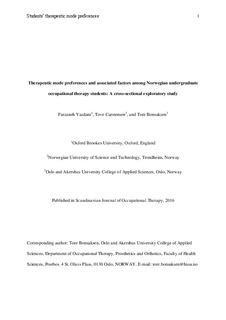Therapeutic mode preferences and associated factors among Norwegian occupational therapy students: A cross-sectional exploratory study
Journal article, Peer reviewed
Permanent lenke
http://hdl.handle.net/11250/2426693Utgivelsesdato
2016Metadata
Vis full innførselSamlinger
Originalversjon
Scandinavian Journal of Occupational Therapy http://dx.doi.org/10.1080/11038128.2016.1220620Sammendrag
Background: The Intentional Relationship Model is specifically focused on the relational aspect of therapy. The model describes six therapeutic modes; these represent different types of interaction for the therapist. However, preferences for therapeutic mode use are under researched.
Aims: This study aims to describe preferences for therapeutic modes in undergraduate occupational therapy students, as well as to explore factors associated to each of the therapeutic modes.
Methods: A sample of 96 occupational therapy students, based at two different Norwegian universities, participated in the study. They completed the Norwegian Self-Assessment of Modes Questionnaire along with sociodemographic information. Descriptive analysis, bivariate correlation and linear regression analysis were employed.
Results: The problem-solving mode was most frequently endorsed. There were generally weak associations between the variables, but female sex and being a student in the education program in Trondheim were associated with higher preference for collaboration.
Conclusion: There is diversity in students’ preferences for the modes, but the problem-solving mode was the most preferred. Students need to be aware of the mode they feel more comfortable with and make sure they use modes that fit with the specific client.
Significance: The occupational therapy education programs need to incorporate raising awareness about therapeutic modes.
